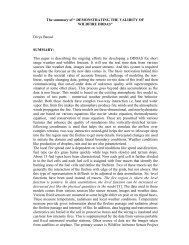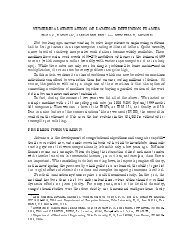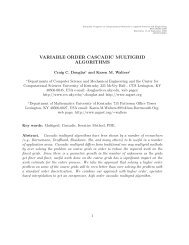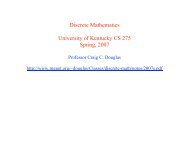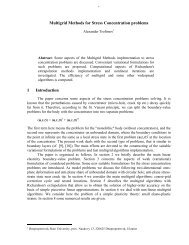Discrete Mathematics University of Kentucky CS 275 Spring ... - MGNet
Discrete Mathematics University of Kentucky CS 275 Spring ... - MGNet
Discrete Mathematics University of Kentucky CS 275 Spring ... - MGNet
You also want an ePaper? Increase the reach of your titles
YUMPU automatically turns print PDFs into web optimized ePapers that Google loves.
Definition: An implicant is sum term or product term <strong>of</strong> one or more minterms<br />
in a sum <strong>of</strong> products. A prime implicant <strong>of</strong> a function is an implicant that cannot<br />
be covered by a more reduced (i.e., one with fewer literals) implicant.<br />
Note: Suppose f is a Boolean function and P is a product term. Then P is an<br />
implicant <strong>of</strong> f if f takes the value 1 whenever P takes the value 1. This is<br />
sometimes written as P ; f in the natural ordering <strong>of</strong> the Boolean algebra.<br />
Quine-McCluskey: This algorithm has two steps:<br />
1. Find all prime implicants <strong>of</strong> the function.<br />
2. Use those prime implicants in a prime implicant chart to find the essential<br />
prime implicants <strong>of</strong> the function as well as other prime implicants that are<br />
necessary to cover the function.<br />
The algorithm constructs a table and then simplifies the table. The method leads<br />
to computer implementations for large numbers <strong>of</strong> variables. Use high quality<br />
s<strong>of</strong>tware if you use the Quine-McCluskey approach.<br />
217



